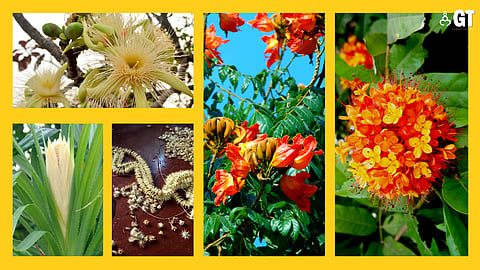

The months of February and March bring in a lot of changes in nature. It is the start of spring and that’s the reason we come across so many flowering trees in our neighbourhood as well as in forested areas.
And, with the Festival of Colour just around the corner, here are some flowering trees, which you can’t miss if you look around and above!
Surangi tree (Mammea suriga)
This is a flowering tree which is in bloom these days. This tree is actually endemic to the Western Ghats, and is rarely seen in urban spaces. However, it is found at Jogger’s Park, Altinho, Panjim.
Flowers bloom on the bark of the tree and are one of the prettiest flowers. The flowers find mention in local folk songs, and there’s also a gold hair accessory worn by married Goan ladies which is inspired by these flowers. It is known as Surnaga Valesar.
Wild Guava tree (Careya arborea)
This is a forest species, but is easily found in urban spaces like Porvorim. It flowers at this time of the year when the tree sheds its leaves. The tree flowers at night and they are pollinated by bats. Flowers have a strong fragrance.
The bark of this tree is used to make ropes in rural parts of Goa.
Red Cotton Silk tree (Bombax ceiba)
The flowering of this tree indicates changes in seasons. The tree sheds all its leaves and then starts flowering. It attracts many species of birds who get nectar from these big bright, red flowers. Its pods contain soft cotton.
Ovlam/ Vavla/Bakul tree (Mimusops elengi L.)
It is a highly fragrant flowering tree, known for its tiny, star-shaped flowers. These flowers have a strong sme
The flowers of Ovlam/Bakul are locally used to make garlands and, thus, for worshipping. A garland of these flowers is a must at a Hindu Goan wedding.
Sita Ashok (Saraca asoca)
This tree, which is usually found in forested areas of Goa, happens to be growing quietly in some corners of Panjim city. It is usually seen in forested areas near water bodies. It starts flowering in spring with flowers that are a pretty orange-red in colour.
African Tulip Tree (Spathodea campanulata)
This is an ideal avenue tree which is known for its bright orange flowers. This tall tree, which can grow upto 25 m, is in its flowering stages these days.
It is exotic as it is native to tropical dry forests of Africa.
Kawaso/kewda or Fragrant Screw Pine
This is a pine, and not a tree, and is mainly found around wetland areas. It is an integral part of Goa’s biodiversity as well as the culture and festivities.
It is known for its fragrant flowers that bloom at this time of the year.
Copper Pod Tree (Peltrophorum pterocarpus)
The easiest way to identify this tree is by looking for a carpet of papery, yellow flowers. This is one of the most common trees of Goa and found mostly in urban areas.
The beautiful yellow flowers on a green canopy add much beauty to our cities.